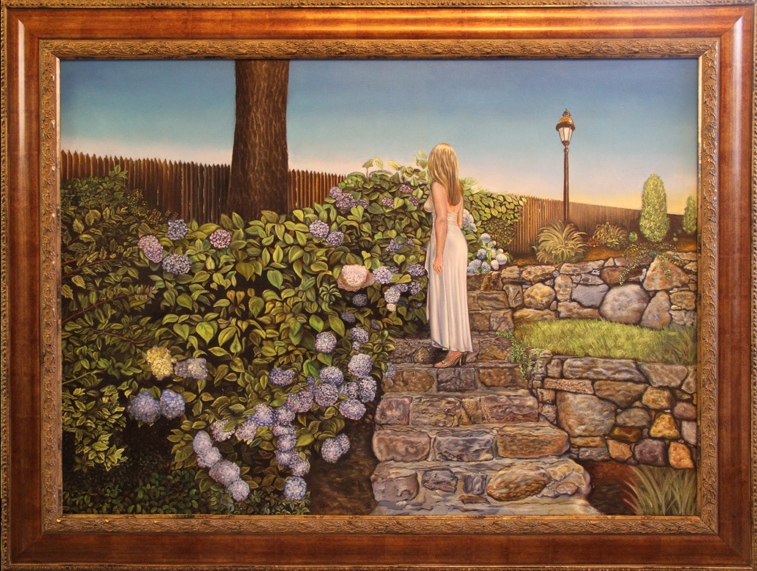The Journey
 As a result of my last show at the Paterson Museum, I was fortunate enough to be commissioned to do a large painting by a benevolent and philanthropic local business owner. The focus of the painting is a rather intense subject. Conceptually it can be approached from many different angles, with the inclusion of a multitude of representational symbols to convey the message, of something which occurs naturally among each and every one of us as part of life’s process. I was given total artistic freedom to compose anything I’d like. Although, the painting is about one big line we must all cross, I do realize, there are lines I cannot cross due to the intensity of the subject matter.
As a result of my last show at the Paterson Museum, I was fortunate enough to be commissioned to do a large painting by a benevolent and philanthropic local business owner. The focus of the painting is a rather intense subject. Conceptually it can be approached from many different angles, with the inclusion of a multitude of representational symbols to convey the message, of something which occurs naturally among each and every one of us as part of life’s process. I was given total artistic freedom to compose anything I’d like. Although, the painting is about one big line we must all cross, I do realize, there are lines I cannot cross due to the intensity of the subject matter.
Somehow, I have to create an image powerful enough to capture a viewer’s attention, and then keep it long enough to convey a message to the viewer, impact and redirect thoughts from that which you were originally focused on and cause the provocative pondering of greater subjects.
The symbols: There are some I will point out and some I will leave for the human subconscious to see or not see. As the phrase goes, “We’ll leave something for the imagination.”
The figure is seen wearing a white flowing dress. The white dress is a symbol of purity and has a positive connotation, which is how we are born into this world as well as how we depart from it. It also represents new beginnings, safety, good-ness, cleanliness and is considered to be the color of perfection. In the Southeast Asian countries, white represents death.
You’ll notice the head of the figure is not facing us, the viewers. That is because the Greeks believed the eyes to be the window to the soul. Without the eyes, it cannot have a soul. Therefore, it must not…? In Greek sculptures, you’ll find their incredibly accurate three-dimensional works are created without eyes.
The head of our traveling subject is turned toward a greater power or spirit, which is represented by light. Exactly what is she looking at and what is she thinking? There is a man-made lamp, which stands before her on the upper level as well as the larger, brightly lit sky. The lamp is a symbol of guidance as she finds her way towards the great force of the persuasive spirit represented by light. The depiction of her body turned towards the Hydrangeas and her head facing the light shows the transition of the figures departure from this Earth.
As the figure’s body is facing the beautiful, robust, blooms of Hydrangea, you’ll notice she seems to be losing interest in the present life on Earth by the alluring, golden light in the distance.
The full blooms represent life and the choice of Hydrangea (a Chinese flower) is significant as it represents expressing love and gratitude (enlightenment) which is what we, the grieve-stricken mourners, are left to do as we pay our last respects to our beloved departed for all they he/she has given us while sharing this life with us. The color in which the flowers are painted is also significant because blues and purples contribute meaning as well. For instance, blue hues convey serenity, peace and security. Light purple has a nostalgic association, and very much what we tend to be after a loved one moves on.
The steps on which the figure stands are structured in stone, which is unmistakably a symbol of Earth, since it is essentially what the earth is made of. Each individual step is representative of time and clarity. As we move further up the steps, the end of our time here becomes clearer to us from this vantage point, and we begin to prepare for our next journey in the distance. The steps also represent ascendance and the movement upward, towards the heavens. As we move further up the steps of life, we begin to think and see in terms of our life’s absolutions more clearly and closer to the top in reference of time.
When I was asked about the fence and its importance and relevance to the composition of the painting, my response was, “Because it defines that the observers are still on this side of it.”
The last bit of representation is up to your own individual perception and how such a transition is perceived. Is the light in the sky that of dusk or dawn. Is it rising or setting and is it the beginning of a new day or the end? Or does it mean something entirely different? Feel free to peruse and scan the rest of the painting for other symbolic references (which haven’t been made obvious) peppered throughout. Without actually saying the painting’s theme, I’m certain I’ve given enough hints (whether in writing or through depiction) for a conclusion to be made.




